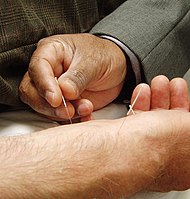
Photo from wikipedia
Electro-acupuncture (EA) has been used for clinic analgesia for many years. However, its mechanisms are not fully understood. We recently reported that AXL, a tyrosine kinase receptor, contributes to the… Click to show full abstract
Electro-acupuncture (EA) has been used for clinic analgesia for many years. However, its mechanisms are not fully understood. We recently reported that AXL, a tyrosine kinase receptor, contributes to the peripheral mechanism of neuropathic pain. We here aim to figure out the significance of EA on neuropathic pain mediated by AXL in dorsal root ganglion (DRG). Spinal nerve ligation (SNL) was used as a neuropathic pain model. EA was applied at ‘‘Huantiao’’ (GB-30) and ‘‘Yanglingquan’’ (GB-34) acupoints for 30 min daily from day 7 to day 10 after SNL. EA not only gradually attenuated SNL-induced mechanical allodynia, but also suppressed the expression of phosphorylated AXL (p-AXL) and AXL in injured DRGs of SNL rats examined by western blotting and immunofluorescence. Moreover, intrathecal injection of the subthreshold dose of AXL inhibitor TP0903, significantly prolonged the analgesic time of single EA treatment and enhanced the analgesic effect of repeated EA treatments, suggesting a synergic effect of EA and AXL inhibitor. These results indicate that AXL signaling underlies EA analgesia and combination of AXL inhibitor and EA might be a new strategy for clinic analgesia on neuropathic pain.
Journal Title: Neurochemical Research
Year Published: 2021
Link to full text (if available)
Share on Social Media: Sign Up to like & get
recommendations!